Exploring Homelessness and Poverty in Britain
VerifiedAdded on 2021/02/22
|13
|3680
|121
AI Summary
The assignment provided is a study on homelessness and poverty in Britain. It discusses various causes of increase in homelessness such as domestic violence, poverty, relationship or family breakdown, structural factors, shortage of affordable houses, and many other similar types of factors. The study also focuses on the issue of homelessness, which can be discussed as a person living in streets, or they are moving from places to places, moving in temporary shelters like houses of family members, friends, or emergency accommodations. It was found that at least 320000 people are homeless in Britain.
Contribute Materials
Your contribution can guide someone’s learning journey. Share your
documents today.
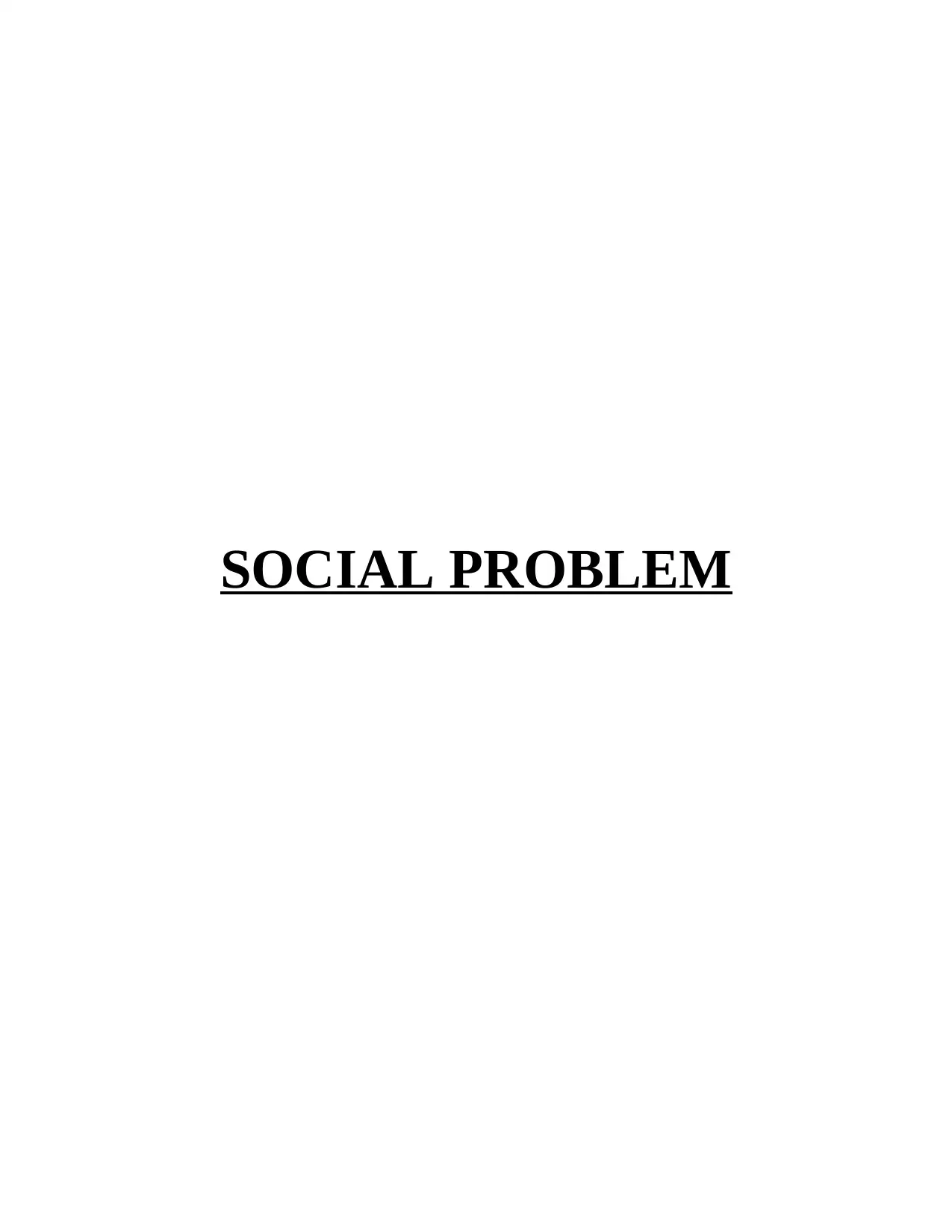
SOCIAL PROBLEM
Secure Best Marks with AI Grader
Need help grading? Try our AI Grader for instant feedback on your assignments.
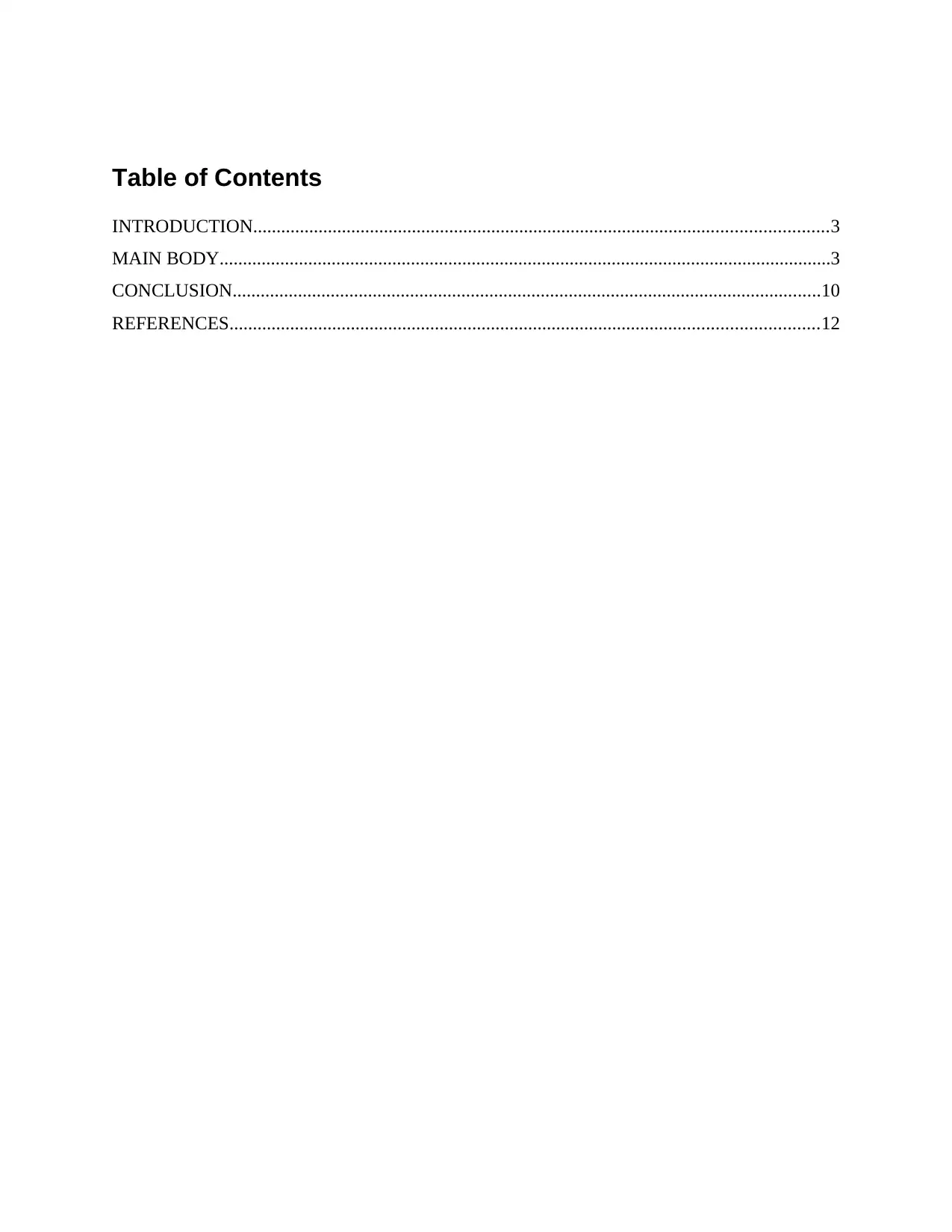
Table of Contents
INTRODUCTION...........................................................................................................................3
MAIN BODY...................................................................................................................................3
CONCLUSION..............................................................................................................................10
REFERENCES..............................................................................................................................12
INTRODUCTION...........................................................................................................................3
MAIN BODY...................................................................................................................................3
CONCLUSION..............................................................................................................................10
REFERENCES..............................................................................................................................12
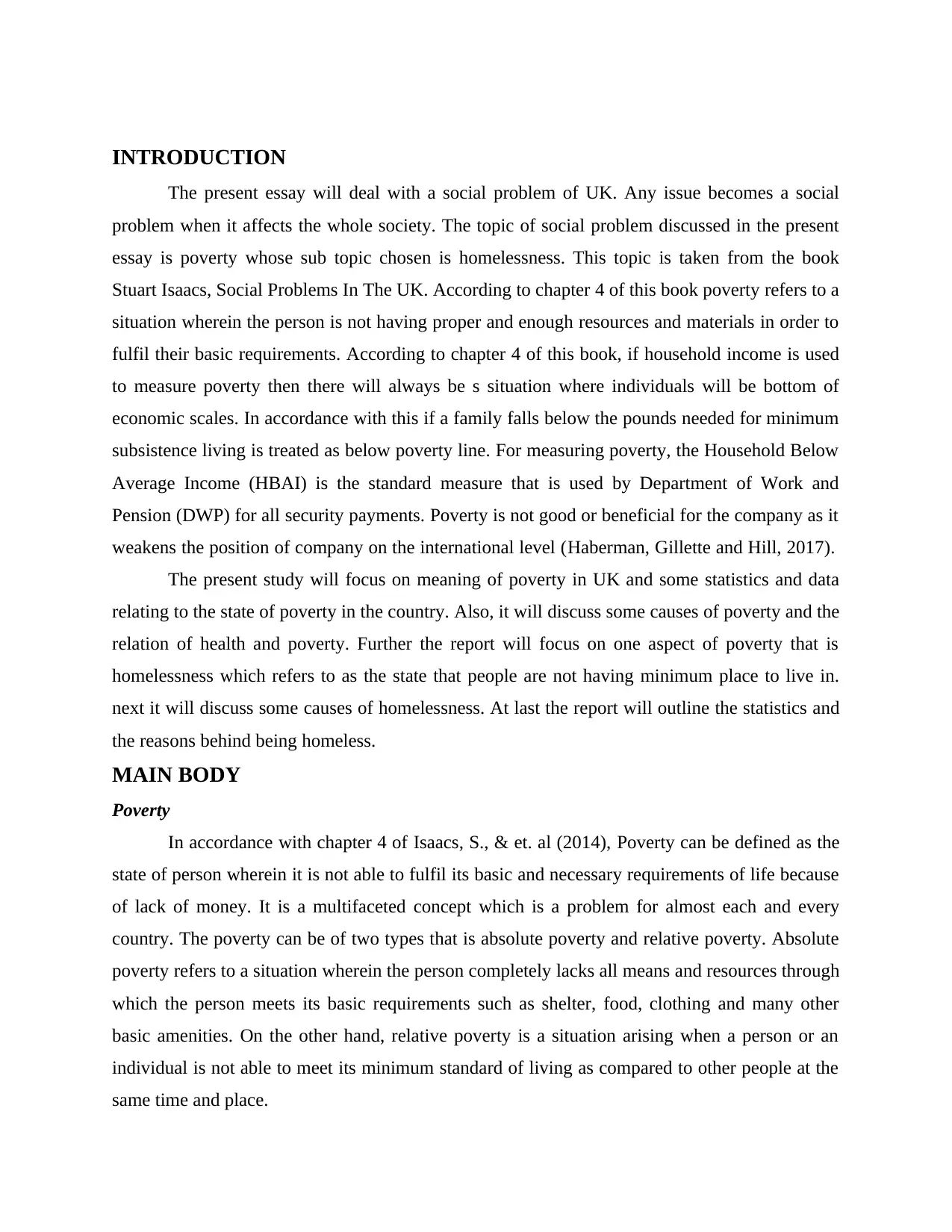
INTRODUCTION
The present essay will deal with a social problem of UK. Any issue becomes a social
problem when it affects the whole society. The topic of social problem discussed in the present
essay is poverty whose sub topic chosen is homelessness. This topic is taken from the book
Stuart Isaacs, Social Problems In The UK. According to chapter 4 of this book poverty refers to a
situation wherein the person is not having proper and enough resources and materials in order to
fulfil their basic requirements. According to chapter 4 of this book, if household income is used
to measure poverty then there will always be s situation where individuals will be bottom of
economic scales. In accordance with this if a family falls below the pounds needed for minimum
subsistence living is treated as below poverty line. For measuring poverty, the Household Below
Average Income (HBAI) is the standard measure that is used by Department of Work and
Pension (DWP) for all security payments. Poverty is not good or beneficial for the company as it
weakens the position of company on the international level (Haberman, Gillette and Hill, 2017).
The present study will focus on meaning of poverty in UK and some statistics and data
relating to the state of poverty in the country. Also, it will discuss some causes of poverty and the
relation of health and poverty. Further the report will focus on one aspect of poverty that is
homelessness which refers to as the state that people are not having minimum place to live in.
next it will discuss some causes of homelessness. At last the report will outline the statistics and
the reasons behind being homeless.
MAIN BODY
Poverty
In accordance with chapter 4 of Isaacs, S., & et. al (2014), Poverty can be defined as the
state of person wherein it is not able to fulfil its basic and necessary requirements of life because
of lack of money. It is a multifaceted concept which is a problem for almost each and every
country. The poverty can be of two types that is absolute poverty and relative poverty. Absolute
poverty refers to a situation wherein the person completely lacks all means and resources through
which the person meets its basic requirements such as shelter, food, clothing and many other
basic amenities. On the other hand, relative poverty is a situation arising when a person or an
individual is not able to meet its minimum standard of living as compared to other people at the
same time and place.
The present essay will deal with a social problem of UK. Any issue becomes a social
problem when it affects the whole society. The topic of social problem discussed in the present
essay is poverty whose sub topic chosen is homelessness. This topic is taken from the book
Stuart Isaacs, Social Problems In The UK. According to chapter 4 of this book poverty refers to a
situation wherein the person is not having proper and enough resources and materials in order to
fulfil their basic requirements. According to chapter 4 of this book, if household income is used
to measure poverty then there will always be s situation where individuals will be bottom of
economic scales. In accordance with this if a family falls below the pounds needed for minimum
subsistence living is treated as below poverty line. For measuring poverty, the Household Below
Average Income (HBAI) is the standard measure that is used by Department of Work and
Pension (DWP) for all security payments. Poverty is not good or beneficial for the company as it
weakens the position of company on the international level (Haberman, Gillette and Hill, 2017).
The present study will focus on meaning of poverty in UK and some statistics and data
relating to the state of poverty in the country. Also, it will discuss some causes of poverty and the
relation of health and poverty. Further the report will focus on one aspect of poverty that is
homelessness which refers to as the state that people are not having minimum place to live in.
next it will discuss some causes of homelessness. At last the report will outline the statistics and
the reasons behind being homeless.
MAIN BODY
Poverty
In accordance with chapter 4 of Isaacs, S., & et. al (2014), Poverty can be defined as the
state of person wherein it is not able to fulfil its basic and necessary requirements of life because
of lack of money. It is a multifaceted concept which is a problem for almost each and every
country. The poverty can be of two types that is absolute poverty and relative poverty. Absolute
poverty refers to a situation wherein the person completely lacks all means and resources through
which the person meets its basic requirements such as shelter, food, clothing and many other
basic amenities. On the other hand, relative poverty is a situation arising when a person or an
individual is not able to meet its minimum standard of living as compared to other people at the
same time and place.
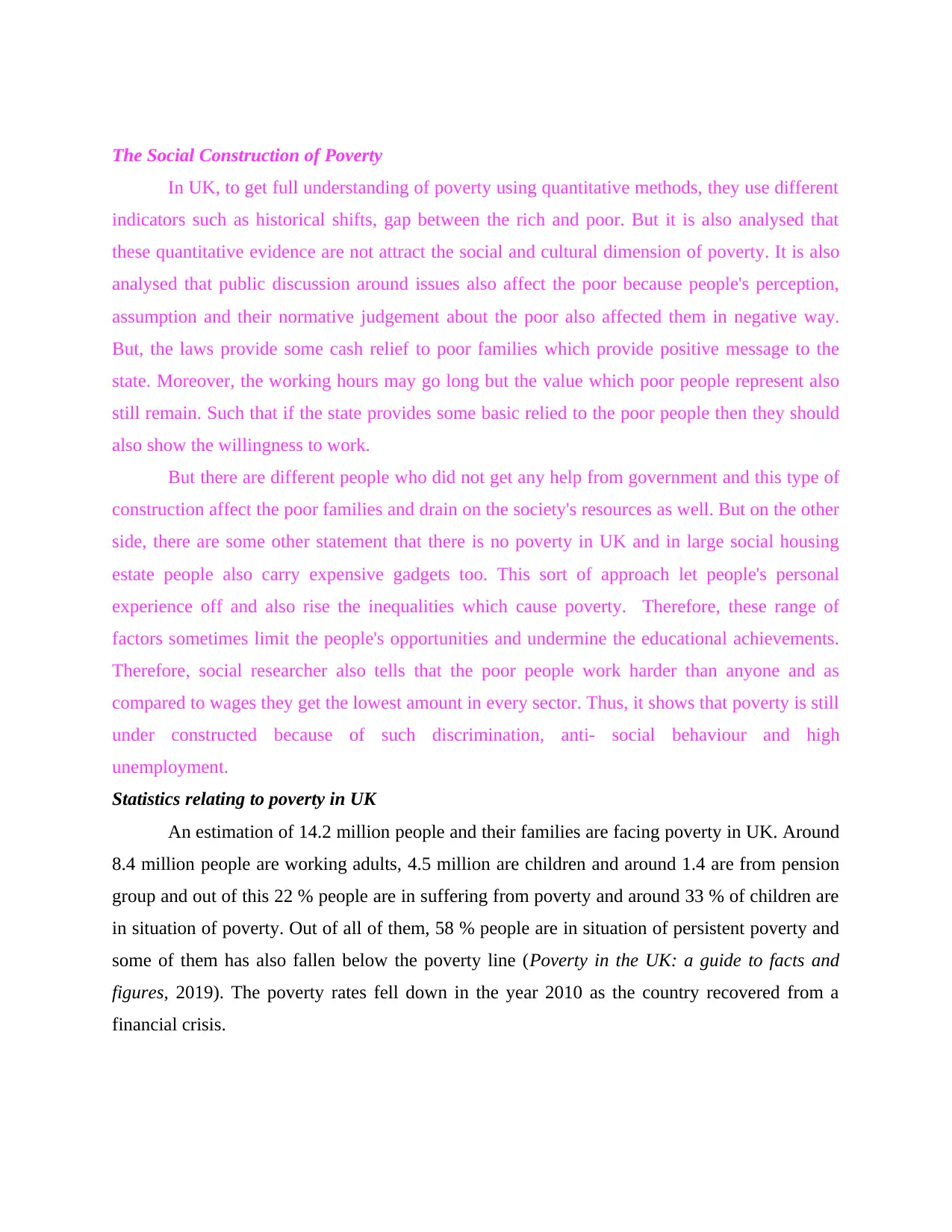
The Social Construction of Poverty
In UK, to get full understanding of poverty using quantitative methods, they use different
indicators such as historical shifts, gap between the rich and poor. But it is also analysed that
these quantitative evidence are not attract the social and cultural dimension of poverty. It is also
analysed that public discussion around issues also affect the poor because people's perception,
assumption and their normative judgement about the poor also affected them in negative way.
But, the laws provide some cash relief to poor families which provide positive message to the
state. Moreover, the working hours may go long but the value which poor people represent also
still remain. Such that if the state provides some basic relied to the poor people then they should
also show the willingness to work.
But there are different people who did not get any help from government and this type of
construction affect the poor families and drain on the society's resources as well. But on the other
side, there are some other statement that there is no poverty in UK and in large social housing
estate people also carry expensive gadgets too. This sort of approach let people's personal
experience off and also rise the inequalities which cause poverty. Therefore, these range of
factors sometimes limit the people's opportunities and undermine the educational achievements.
Therefore, social researcher also tells that the poor people work harder than anyone and as
compared to wages they get the lowest amount in every sector. Thus, it shows that poverty is still
under constructed because of such discrimination, anti- social behaviour and high
unemployment.
Statistics relating to poverty in UK
An estimation of 14.2 million people and their families are facing poverty in UK. Around
8.4 million people are working adults, 4.5 million are children and around 1.4 are from pension
group and out of this 22 % people are in suffering from poverty and around 33 % of children are
in situation of poverty. Out of all of them, 58 % people are in situation of persistent poverty and
some of them has also fallen below the poverty line (Poverty in the UK: a guide to facts and
figures, 2019). The poverty rates fell down in the year 2010 as the country recovered from a
financial crisis.
In UK, to get full understanding of poverty using quantitative methods, they use different
indicators such as historical shifts, gap between the rich and poor. But it is also analysed that
these quantitative evidence are not attract the social and cultural dimension of poverty. It is also
analysed that public discussion around issues also affect the poor because people's perception,
assumption and their normative judgement about the poor also affected them in negative way.
But, the laws provide some cash relief to poor families which provide positive message to the
state. Moreover, the working hours may go long but the value which poor people represent also
still remain. Such that if the state provides some basic relied to the poor people then they should
also show the willingness to work.
But there are different people who did not get any help from government and this type of
construction affect the poor families and drain on the society's resources as well. But on the other
side, there are some other statement that there is no poverty in UK and in large social housing
estate people also carry expensive gadgets too. This sort of approach let people's personal
experience off and also rise the inequalities which cause poverty. Therefore, these range of
factors sometimes limit the people's opportunities and undermine the educational achievements.
Therefore, social researcher also tells that the poor people work harder than anyone and as
compared to wages they get the lowest amount in every sector. Thus, it shows that poverty is still
under constructed because of such discrimination, anti- social behaviour and high
unemployment.
Statistics relating to poverty in UK
An estimation of 14.2 million people and their families are facing poverty in UK. Around
8.4 million people are working adults, 4.5 million are children and around 1.4 are from pension
group and out of this 22 % people are in suffering from poverty and around 33 % of children are
in situation of poverty. Out of all of them, 58 % people are in situation of persistent poverty and
some of them has also fallen below the poverty line (Poverty in the UK: a guide to facts and
figures, 2019). The poverty rates fell down in the year 2010 as the country recovered from a
financial crisis.
Secure Best Marks with AI Grader
Need help grading? Try our AI Grader for instant feedback on your assignments.
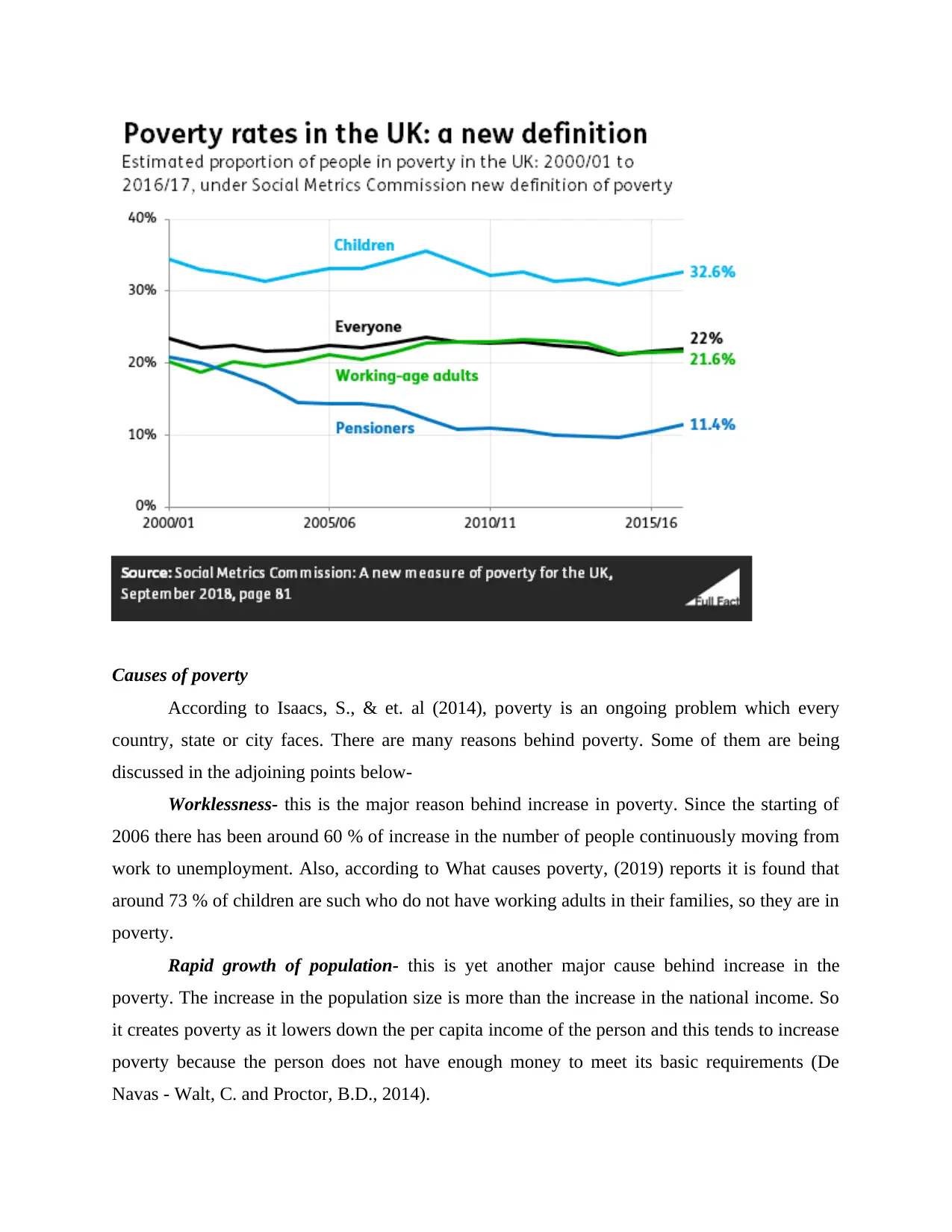
Causes of poverty
According to Isaacs, S., & et. al (2014), poverty is an ongoing problem which every
country, state or city faces. There are many reasons behind poverty. Some of them are being
discussed in the adjoining points below-
Worklessness- this is the major reason behind increase in poverty. Since the starting of
2006 there has been around 60 % of increase in the number of people continuously moving from
work to unemployment. Also, according to What causes poverty, (2019) reports it is found that
around 73 % of children are such who do not have working adults in their families, so they are in
poverty.
Rapid growth of population- this is yet another major cause behind increase in the
poverty. The increase in the population size is more than the increase in the national income. So
it creates poverty as it lowers down the per capita income of the person and this tends to increase
poverty because the person does not have enough money to meet its basic requirements (De
Navas - Walt, C. and Proctor, B.D., 2014).
According to Isaacs, S., & et. al (2014), poverty is an ongoing problem which every
country, state or city faces. There are many reasons behind poverty. Some of them are being
discussed in the adjoining points below-
Worklessness- this is the major reason behind increase in poverty. Since the starting of
2006 there has been around 60 % of increase in the number of people continuously moving from
work to unemployment. Also, according to What causes poverty, (2019) reports it is found that
around 73 % of children are such who do not have working adults in their families, so they are in
poverty.
Rapid growth of population- this is yet another major cause behind increase in the
poverty. The increase in the population size is more than the increase in the national income. So
it creates poverty as it lowers down the per capita income of the person and this tends to increase
poverty because the person does not have enough money to meet its basic requirements (De
Navas - Walt, C. and Proctor, B.D., 2014).
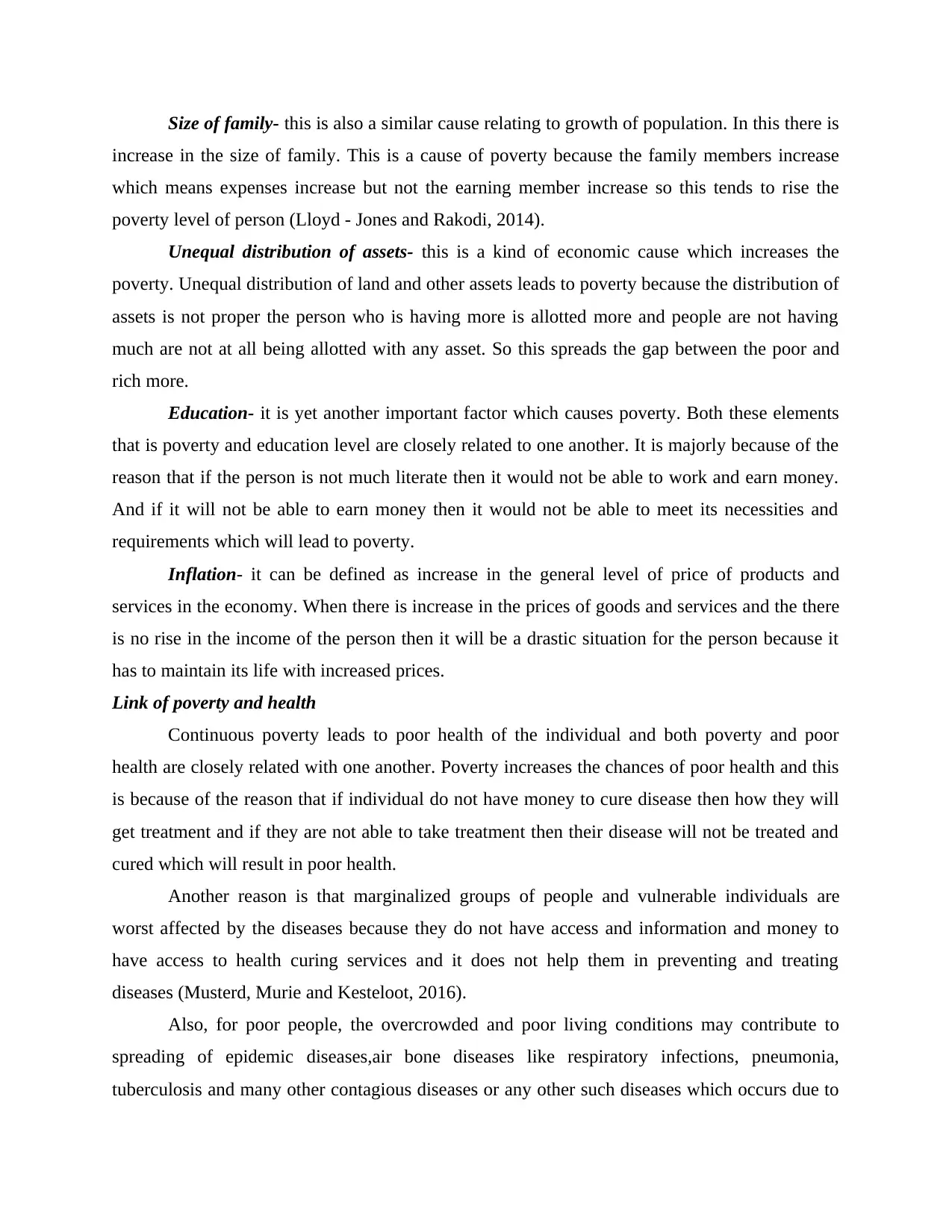
Size of family- this is also a similar cause relating to growth of population. In this there is
increase in the size of family. This is a cause of poverty because the family members increase
which means expenses increase but not the earning member increase so this tends to rise the
poverty level of person (Lloyd - Jones and Rakodi, 2014).
Unequal distribution of assets- this is a kind of economic cause which increases the
poverty. Unequal distribution of land and other assets leads to poverty because the distribution of
assets is not proper the person who is having more is allotted more and people are not having
much are not at all being allotted with any asset. So this spreads the gap between the poor and
rich more.
Education- it is yet another important factor which causes poverty. Both these elements
that is poverty and education level are closely related to one another. It is majorly because of the
reason that if the person is not much literate then it would not be able to work and earn money.
And if it will not be able to earn money then it would not be able to meet its necessities and
requirements which will lead to poverty.
Inflation- it can be defined as increase in the general level of price of products and
services in the economy. When there is increase in the prices of goods and services and the there
is no rise in the income of the person then it will be a drastic situation for the person because it
has to maintain its life with increased prices.
Link of poverty and health
Continuous poverty leads to poor health of the individual and both poverty and poor
health are closely related with one another. Poverty increases the chances of poor health and this
is because of the reason that if individual do not have money to cure disease then how they will
get treatment and if they are not able to take treatment then their disease will not be treated and
cured which will result in poor health.
Another reason is that marginalized groups of people and vulnerable individuals are
worst affected by the diseases because they do not have access and information and money to
have access to health curing services and it does not help them in preventing and treating
diseases (Musterd, Murie and Kesteloot, 2016).
Also, for poor people, the overcrowded and poor living conditions may contribute to
spreading of epidemic diseases,air bone diseases like respiratory infections, pneumonia,
tuberculosis and many other contagious diseases or any other such diseases which occurs due to
increase in the size of family. This is a cause of poverty because the family members increase
which means expenses increase but not the earning member increase so this tends to rise the
poverty level of person (Lloyd - Jones and Rakodi, 2014).
Unequal distribution of assets- this is a kind of economic cause which increases the
poverty. Unequal distribution of land and other assets leads to poverty because the distribution of
assets is not proper the person who is having more is allotted more and people are not having
much are not at all being allotted with any asset. So this spreads the gap between the poor and
rich more.
Education- it is yet another important factor which causes poverty. Both these elements
that is poverty and education level are closely related to one another. It is majorly because of the
reason that if the person is not much literate then it would not be able to work and earn money.
And if it will not be able to earn money then it would not be able to meet its necessities and
requirements which will lead to poverty.
Inflation- it can be defined as increase in the general level of price of products and
services in the economy. When there is increase in the prices of goods and services and the there
is no rise in the income of the person then it will be a drastic situation for the person because it
has to maintain its life with increased prices.
Link of poverty and health
Continuous poverty leads to poor health of the individual and both poverty and poor
health are closely related with one another. Poverty increases the chances of poor health and this
is because of the reason that if individual do not have money to cure disease then how they will
get treatment and if they are not able to take treatment then their disease will not be treated and
cured which will result in poor health.
Another reason is that marginalized groups of people and vulnerable individuals are
worst affected by the diseases because they do not have access and information and money to
have access to health curing services and it does not help them in preventing and treating
diseases (Musterd, Murie and Kesteloot, 2016).
Also, for poor people, the overcrowded and poor living conditions may contribute to
spreading of epidemic diseases,air bone diseases like respiratory infections, pneumonia,
tuberculosis and many other contagious diseases or any other such diseases which occurs due to
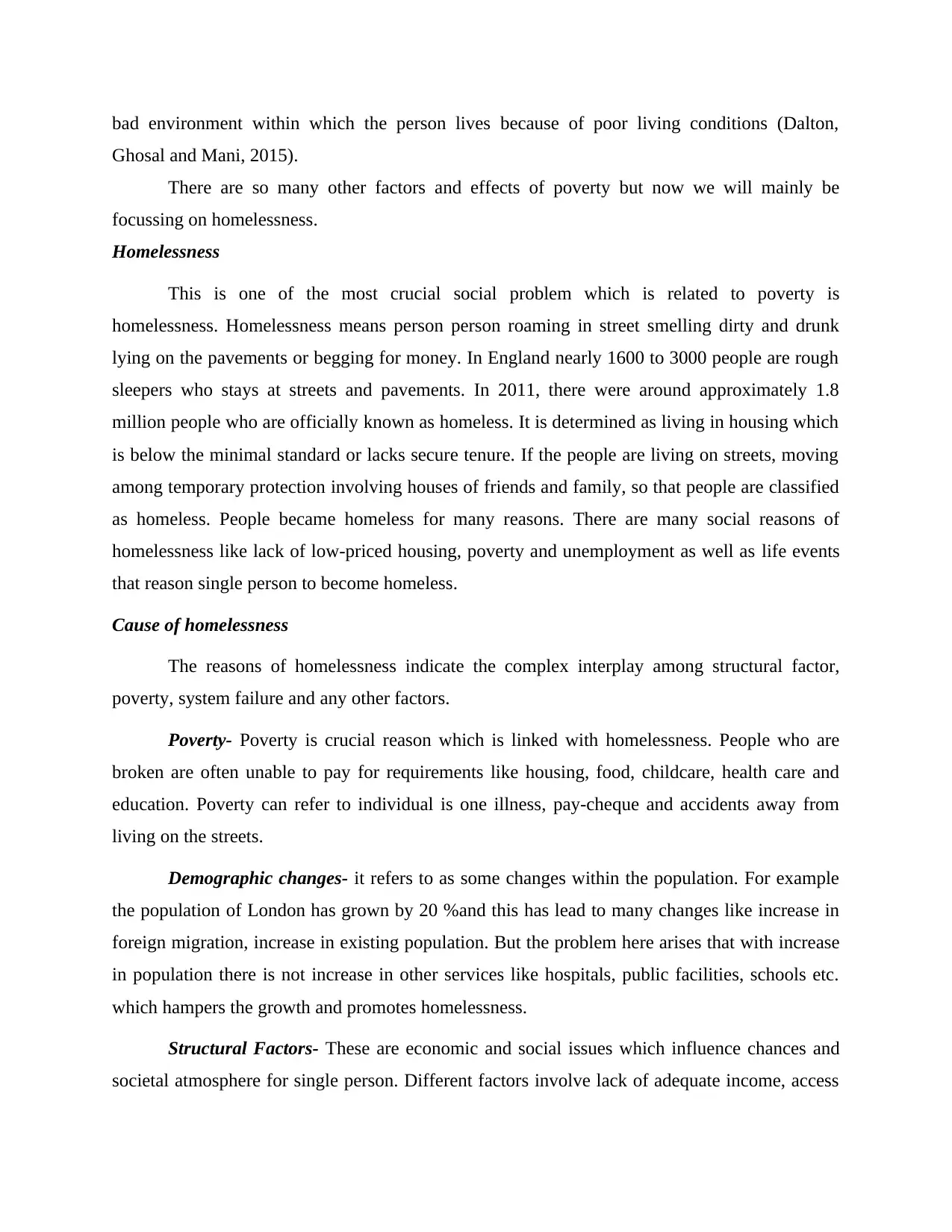
bad environment within which the person lives because of poor living conditions (Dalton,
Ghosal and Mani, 2015).
There are so many other factors and effects of poverty but now we will mainly be
focussing on homelessness.
Homelessness
This is one of the most crucial social problem which is related to poverty is
homelessness. Homelessness means person person roaming in street smelling dirty and drunk
lying on the pavements or begging for money. In England nearly 1600 to 3000 people are rough
sleepers who stays at streets and pavements. In 2011, there were around approximately 1.8
million people who are officially known as homeless. It is determined as living in housing which
is below the minimal standard or lacks secure tenure. If the people are living on streets, moving
among temporary protection involving houses of friends and family, so that people are classified
as homeless. People became homeless for many reasons. There are many social reasons of
homelessness like lack of low-priced housing, poverty and unemployment as well as life events
that reason single person to become homeless.
Cause of homelessness
The reasons of homelessness indicate the complex interplay among structural factor,
poverty, system failure and any other factors.
Poverty- Poverty is crucial reason which is linked with homelessness. People who are
broken are often unable to pay for requirements like housing, food, childcare, health care and
education. Poverty can refer to individual is one illness, pay-cheque and accidents away from
living on the streets.
Demographic changes- it refers to as some changes within the population. For example
the population of London has grown by 20 %and this has lead to many changes like increase in
foreign migration, increase in existing population. But the problem here arises that with increase
in population there is not increase in other services like hospitals, public facilities, schools etc.
which hampers the growth and promotes homelessness.
Structural Factors- These are economic and social issues which influence chances and
societal atmosphere for single person. Different factors involve lack of adequate income, access
Ghosal and Mani, 2015).
There are so many other factors and effects of poverty but now we will mainly be
focussing on homelessness.
Homelessness
This is one of the most crucial social problem which is related to poverty is
homelessness. Homelessness means person person roaming in street smelling dirty and drunk
lying on the pavements or begging for money. In England nearly 1600 to 3000 people are rough
sleepers who stays at streets and pavements. In 2011, there were around approximately 1.8
million people who are officially known as homeless. It is determined as living in housing which
is below the minimal standard or lacks secure tenure. If the people are living on streets, moving
among temporary protection involving houses of friends and family, so that people are classified
as homeless. People became homeless for many reasons. There are many social reasons of
homelessness like lack of low-priced housing, poverty and unemployment as well as life events
that reason single person to become homeless.
Cause of homelessness
The reasons of homelessness indicate the complex interplay among structural factor,
poverty, system failure and any other factors.
Poverty- Poverty is crucial reason which is linked with homelessness. People who are
broken are often unable to pay for requirements like housing, food, childcare, health care and
education. Poverty can refer to individual is one illness, pay-cheque and accidents away from
living on the streets.
Demographic changes- it refers to as some changes within the population. For example
the population of London has grown by 20 %and this has lead to many changes like increase in
foreign migration, increase in existing population. But the problem here arises that with increase
in population there is not increase in other services like hospitals, public facilities, schools etc.
which hampers the growth and promotes homelessness.
Structural Factors- These are economic and social issues which influence chances and
societal atmosphere for single person. Different factors involve lack of adequate income, access
Paraphrase This Document
Need a fresh take? Get an instant paraphrase of this document with our AI Paraphraser
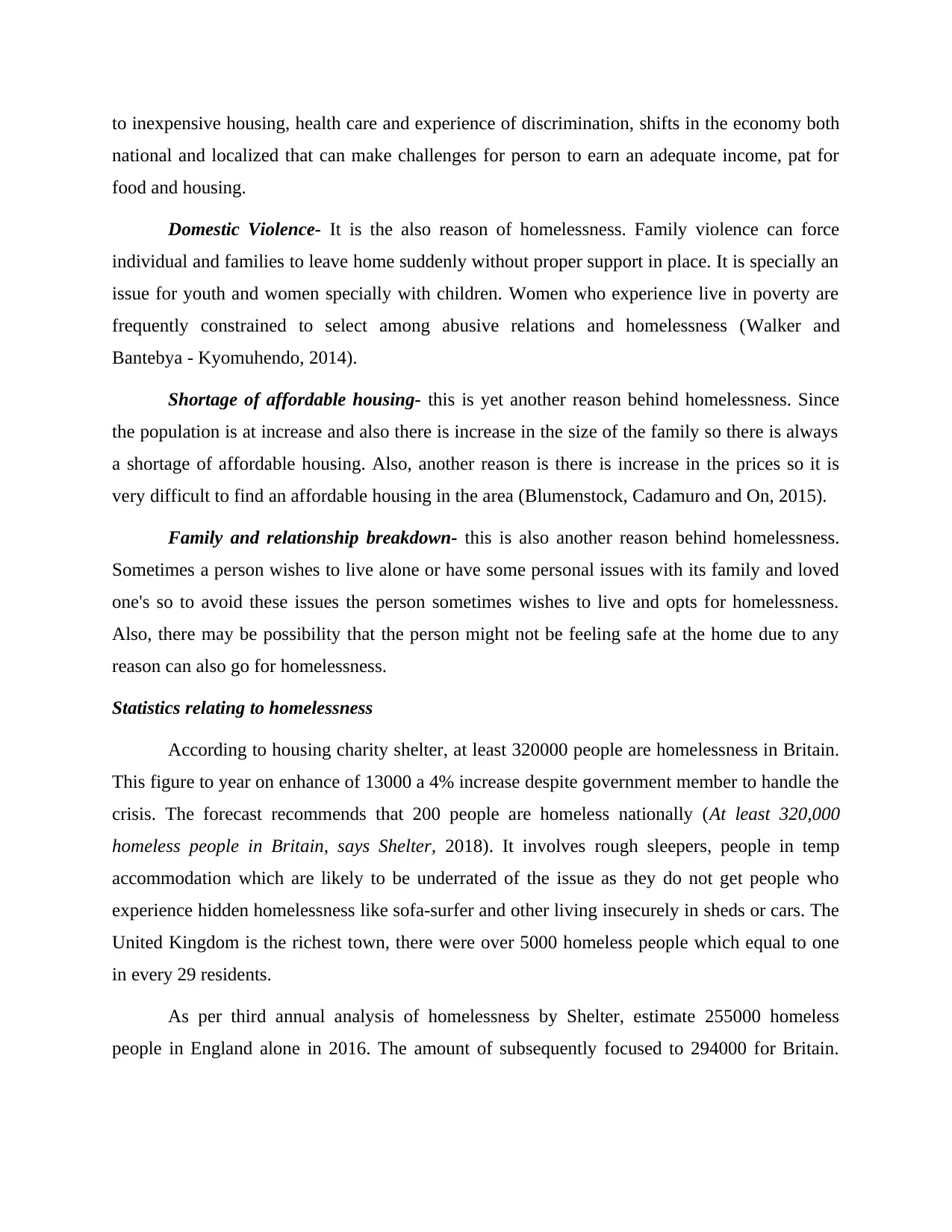
to inexpensive housing, health care and experience of discrimination, shifts in the economy both
national and localized that can make challenges for person to earn an adequate income, pat for
food and housing.
Domestic Violence- It is the also reason of homelessness. Family violence can force
individual and families to leave home suddenly without proper support in place. It is specially an
issue for youth and women specially with children. Women who experience live in poverty are
frequently constrained to select among abusive relations and homelessness (Walker and
Bantebya - Kyomuhendo, 2014).
Shortage of affordable housing- this is yet another reason behind homelessness. Since
the population is at increase and also there is increase in the size of the family so there is always
a shortage of affordable housing. Also, another reason is there is increase in the prices so it is
very difficult to find an affordable housing in the area (Blumenstock, Cadamuro and On, 2015).
Family and relationship breakdown- this is also another reason behind homelessness.
Sometimes a person wishes to live alone or have some personal issues with its family and loved
one's so to avoid these issues the person sometimes wishes to live and opts for homelessness.
Also, there may be possibility that the person might not be feeling safe at the home due to any
reason can also go for homelessness.
Statistics relating to homelessness
According to housing charity shelter, at least 320000 people are homelessness in Britain.
This figure to year on enhance of 13000 a 4% increase despite government member to handle the
crisis. The forecast recommends that 200 people are homeless nationally (At least 320,000
homeless people in Britain, says Shelter, 2018). It involves rough sleepers, people in temp
accommodation which are likely to be underrated of the issue as they do not get people who
experience hidden homelessness like sofa-surfer and other living insecurely in sheds or cars. The
United Kingdom is the richest town, there were over 5000 homeless people which equal to one
in every 29 residents.
As per third annual analysis of homelessness by Shelter, estimate 255000 homeless
people in England alone in 2016. The amount of subsequently focused to 294000 for Britain.
national and localized that can make challenges for person to earn an adequate income, pat for
food and housing.
Domestic Violence- It is the also reason of homelessness. Family violence can force
individual and families to leave home suddenly without proper support in place. It is specially an
issue for youth and women specially with children. Women who experience live in poverty are
frequently constrained to select among abusive relations and homelessness (Walker and
Bantebya - Kyomuhendo, 2014).
Shortage of affordable housing- this is yet another reason behind homelessness. Since
the population is at increase and also there is increase in the size of the family so there is always
a shortage of affordable housing. Also, another reason is there is increase in the prices so it is
very difficult to find an affordable housing in the area (Blumenstock, Cadamuro and On, 2015).
Family and relationship breakdown- this is also another reason behind homelessness.
Sometimes a person wishes to live alone or have some personal issues with its family and loved
one's so to avoid these issues the person sometimes wishes to live and opts for homelessness.
Also, there may be possibility that the person might not be feeling safe at the home due to any
reason can also go for homelessness.
Statistics relating to homelessness
According to housing charity shelter, at least 320000 people are homelessness in Britain.
This figure to year on enhance of 13000 a 4% increase despite government member to handle the
crisis. The forecast recommends that 200 people are homeless nationally (At least 320,000
homeless people in Britain, says Shelter, 2018). It involves rough sleepers, people in temp
accommodation which are likely to be underrated of the issue as they do not get people who
experience hidden homelessness like sofa-surfer and other living insecurely in sheds or cars. The
United Kingdom is the richest town, there were over 5000 homeless people which equal to one
in every 29 residents.
As per third annual analysis of homelessness by Shelter, estimate 255000 homeless
people in England alone in 2016. The amount of subsequently focused to 294000 for Britain.
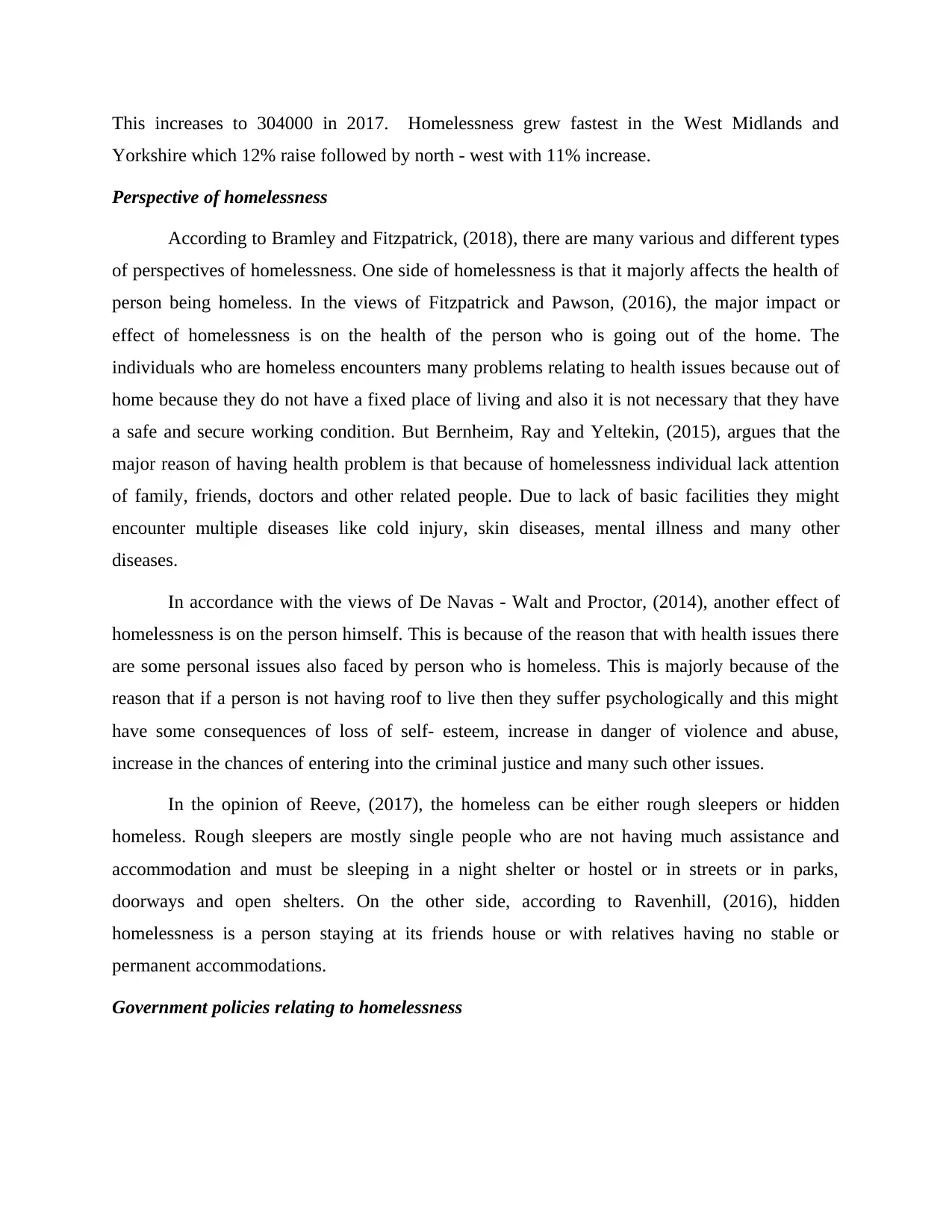
This increases to 304000 in 2017. Homelessness grew fastest in the West Midlands and
Yorkshire which 12% raise followed by north - west with 11% increase.
Perspective of homelessness
According to Bramley and Fitzpatrick, (2018), there are many various and different types
of perspectives of homelessness. One side of homelessness is that it majorly affects the health of
person being homeless. In the views of Fitzpatrick and Pawson, (2016), the major impact or
effect of homelessness is on the health of the person who is going out of the home. The
individuals who are homeless encounters many problems relating to health issues because out of
home because they do not have a fixed place of living and also it is not necessary that they have
a safe and secure working condition. But Bernheim, Ray and Yeltekin, (2015), argues that the
major reason of having health problem is that because of homelessness individual lack attention
of family, friends, doctors and other related people. Due to lack of basic facilities they might
encounter multiple diseases like cold injury, skin diseases, mental illness and many other
diseases.
In accordance with the views of De Navas - Walt and Proctor, (2014), another effect of
homelessness is on the person himself. This is because of the reason that with health issues there
are some personal issues also faced by person who is homeless. This is majorly because of the
reason that if a person is not having roof to live then they suffer psychologically and this might
have some consequences of loss of self- esteem, increase in danger of violence and abuse,
increase in the chances of entering into the criminal justice and many such other issues.
In the opinion of Reeve, (2017), the homeless can be either rough sleepers or hidden
homeless. Rough sleepers are mostly single people who are not having much assistance and
accommodation and must be sleeping in a night shelter or hostel or in streets or in parks,
doorways and open shelters. On the other side, according to Ravenhill, (2016), hidden
homelessness is a person staying at its friends house or with relatives having no stable or
permanent accommodations.
Government policies relating to homelessness
Yorkshire which 12% raise followed by north - west with 11% increase.
Perspective of homelessness
According to Bramley and Fitzpatrick, (2018), there are many various and different types
of perspectives of homelessness. One side of homelessness is that it majorly affects the health of
person being homeless. In the views of Fitzpatrick and Pawson, (2016), the major impact or
effect of homelessness is on the health of the person who is going out of the home. The
individuals who are homeless encounters many problems relating to health issues because out of
home because they do not have a fixed place of living and also it is not necessary that they have
a safe and secure working condition. But Bernheim, Ray and Yeltekin, (2015), argues that the
major reason of having health problem is that because of homelessness individual lack attention
of family, friends, doctors and other related people. Due to lack of basic facilities they might
encounter multiple diseases like cold injury, skin diseases, mental illness and many other
diseases.
In accordance with the views of De Navas - Walt and Proctor, (2014), another effect of
homelessness is on the person himself. This is because of the reason that with health issues there
are some personal issues also faced by person who is homeless. This is majorly because of the
reason that if a person is not having roof to live then they suffer psychologically and this might
have some consequences of loss of self- esteem, increase in danger of violence and abuse,
increase in the chances of entering into the criminal justice and many such other issues.
In the opinion of Reeve, (2017), the homeless can be either rough sleepers or hidden
homeless. Rough sleepers are mostly single people who are not having much assistance and
accommodation and must be sleeping in a night shelter or hostel or in streets or in parks,
doorways and open shelters. On the other side, according to Ravenhill, (2016), hidden
homelessness is a person staying at its friends house or with relatives having no stable or
permanent accommodations.
Government policies relating to homelessness
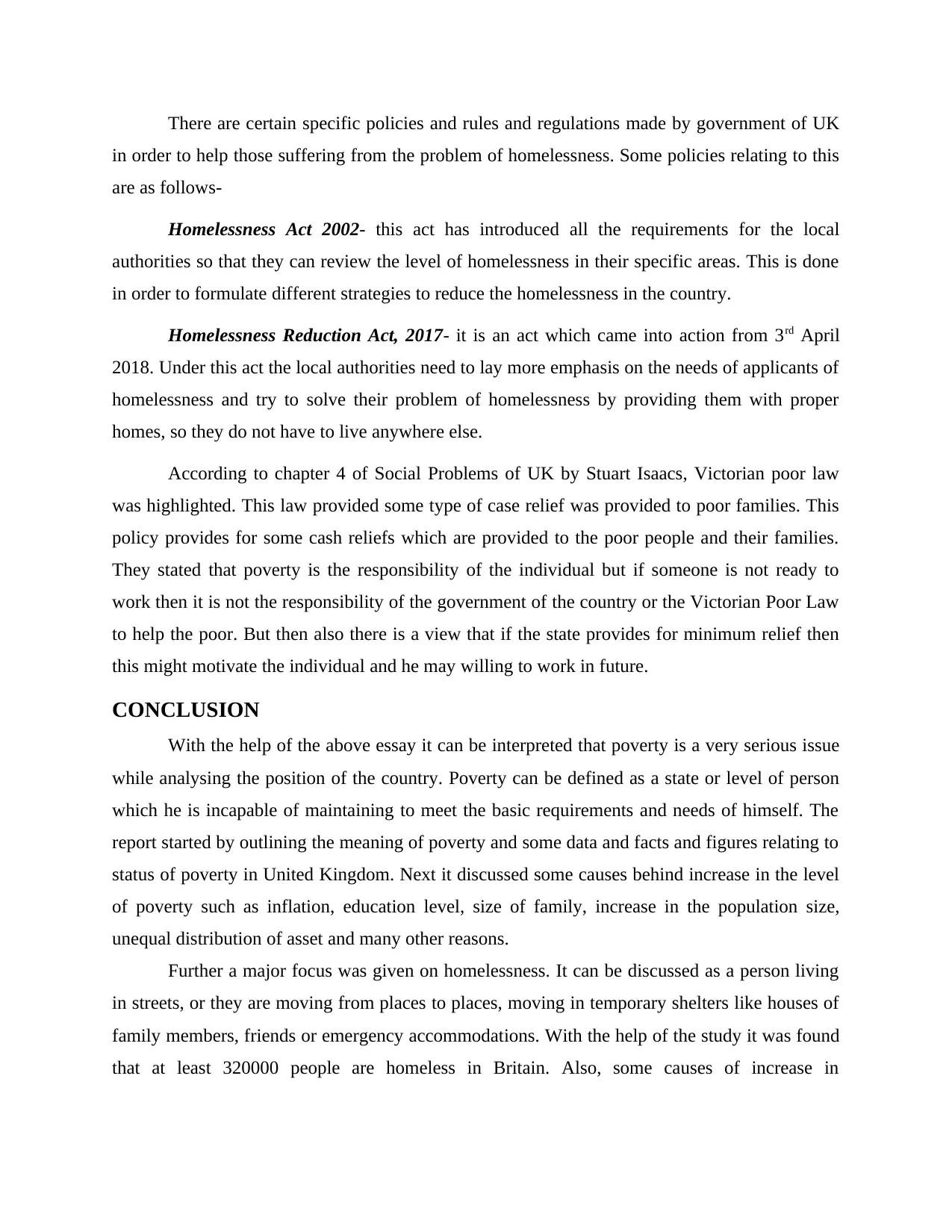
There are certain specific policies and rules and regulations made by government of UK
in order to help those suffering from the problem of homelessness. Some policies relating to this
are as follows-
Homelessness Act 2002- this act has introduced all the requirements for the local
authorities so that they can review the level of homelessness in their specific areas. This is done
in order to formulate different strategies to reduce the homelessness in the country.
Homelessness Reduction Act, 2017- it is an act which came into action from 3rd April
2018. Under this act the local authorities need to lay more emphasis on the needs of applicants of
homelessness and try to solve their problem of homelessness by providing them with proper
homes, so they do not have to live anywhere else.
According to chapter 4 of Social Problems of UK by Stuart Isaacs, Victorian poor law
was highlighted. This law provided some type of case relief was provided to poor families. This
policy provides for some cash reliefs which are provided to the poor people and their families.
They stated that poverty is the responsibility of the individual but if someone is not ready to
work then it is not the responsibility of the government of the country or the Victorian Poor Law
to help the poor. But then also there is a view that if the state provides for minimum relief then
this might motivate the individual and he may willing to work in future.
CONCLUSION
With the help of the above essay it can be interpreted that poverty is a very serious issue
while analysing the position of the country. Poverty can be defined as a state or level of person
which he is incapable of maintaining to meet the basic requirements and needs of himself. The
report started by outlining the meaning of poverty and some data and facts and figures relating to
status of poverty in United Kingdom. Next it discussed some causes behind increase in the level
of poverty such as inflation, education level, size of family, increase in the population size,
unequal distribution of asset and many other reasons.
Further a major focus was given on homelessness. It can be discussed as a person living
in streets, or they are moving from places to places, moving in temporary shelters like houses of
family members, friends or emergency accommodations. With the help of the study it was found
that at least 320000 people are homeless in Britain. Also, some causes of increase in
in order to help those suffering from the problem of homelessness. Some policies relating to this
are as follows-
Homelessness Act 2002- this act has introduced all the requirements for the local
authorities so that they can review the level of homelessness in their specific areas. This is done
in order to formulate different strategies to reduce the homelessness in the country.
Homelessness Reduction Act, 2017- it is an act which came into action from 3rd April
2018. Under this act the local authorities need to lay more emphasis on the needs of applicants of
homelessness and try to solve their problem of homelessness by providing them with proper
homes, so they do not have to live anywhere else.
According to chapter 4 of Social Problems of UK by Stuart Isaacs, Victorian poor law
was highlighted. This law provided some type of case relief was provided to poor families. This
policy provides for some cash reliefs which are provided to the poor people and their families.
They stated that poverty is the responsibility of the individual but if someone is not ready to
work then it is not the responsibility of the government of the country or the Victorian Poor Law
to help the poor. But then also there is a view that if the state provides for minimum relief then
this might motivate the individual and he may willing to work in future.
CONCLUSION
With the help of the above essay it can be interpreted that poverty is a very serious issue
while analysing the position of the country. Poverty can be defined as a state or level of person
which he is incapable of maintaining to meet the basic requirements and needs of himself. The
report started by outlining the meaning of poverty and some data and facts and figures relating to
status of poverty in United Kingdom. Next it discussed some causes behind increase in the level
of poverty such as inflation, education level, size of family, increase in the population size,
unequal distribution of asset and many other reasons.
Further a major focus was given on homelessness. It can be discussed as a person living
in streets, or they are moving from places to places, moving in temporary shelters like houses of
family members, friends or emergency accommodations. With the help of the study it was found
that at least 320000 people are homeless in Britain. Also, some causes of increase in
Secure Best Marks with AI Grader
Need help grading? Try our AI Grader for instant feedback on your assignments.

homelessness are like domestic violence, poverty, relationship or family breakdown, structural
factors, shortage of affordable houses and many other similar types of factors.
factors, shortage of affordable houses and many other similar types of factors.
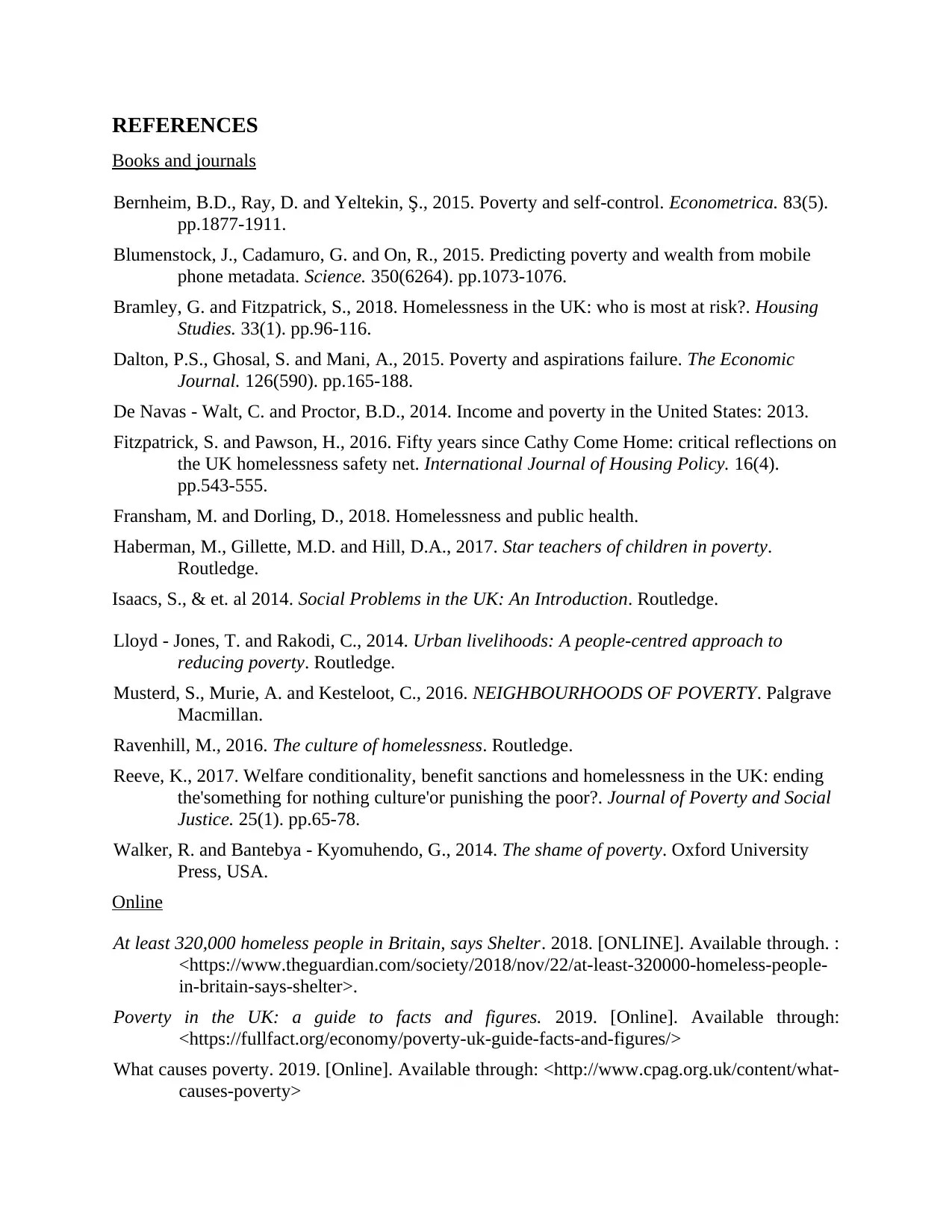
REFERENCES
Books and journals
Bernheim, B.D., Ray, D. and Yeltekin, Ş., 2015. Poverty and self‐control. Econometrica. 83(5).
pp.1877-1911.
Blumenstock, J., Cadamuro, G. and On, R., 2015. Predicting poverty and wealth from mobile
phone metadata. Science. 350(6264). pp.1073-1076.
Bramley, G. and Fitzpatrick, S., 2018. Homelessness in the UK: who is most at risk?. Housing
Studies. 33(1). pp.96-116.
Dalton, P.S., Ghosal, S. and Mani, A., 2015. Poverty and aspirations failure. The Economic
Journal. 126(590). pp.165-188.
De Navas - Walt, C. and Proctor, B.D., 2014. Income and poverty in the United States: 2013.
Fitzpatrick, S. and Pawson, H., 2016. Fifty years since Cathy Come Home: critical reflections on
the UK homelessness safety net. International Journal of Housing Policy. 16(4).
pp.543-555.
Fransham, M. and Dorling, D., 2018. Homelessness and public health.
Haberman, M., Gillette, M.D. and Hill, D.A., 2017. Star teachers of children in poverty.
Routledge.
Isaacs, S., & et. al 2014. Social Problems in the UK: An Introduction. Routledge.
Lloyd - Jones, T. and Rakodi, C., 2014. Urban livelihoods: A people-centred approach to
reducing poverty. Routledge.
Musterd, S., Murie, A. and Kesteloot, C., 2016. NEIGHBOURHOODS OF POVERTY. Palgrave
Macmillan.
Ravenhill, M., 2016. The culture of homelessness. Routledge.
Reeve, K., 2017. Welfare conditionality, benefit sanctions and homelessness in the UK: ending
the'something for nothing culture'or punishing the poor?. Journal of Poverty and Social
Justice. 25(1). pp.65-78.
Walker, R. and Bantebya - Kyomuhendo, G., 2014. The shame of poverty. Oxford University
Press, USA.
Online
At least 320,000 homeless people in Britain, says Shelter. 2018. [ONLINE]. Available through. :
<https://www.theguardian.com/society/2018/nov/22/at-least-320000-homeless-people-
in-britain-says-shelter>.
Poverty in the UK: a guide to facts and figures. 2019. [Online]. Available through:
<https://fullfact.org/economy/poverty-uk-guide-facts-and-figures/>
What causes poverty. 2019. [Online]. Available through: <http://www.cpag.org.uk/content/what-
causes-poverty>
Books and journals
Bernheim, B.D., Ray, D. and Yeltekin, Ş., 2015. Poverty and self‐control. Econometrica. 83(5).
pp.1877-1911.
Blumenstock, J., Cadamuro, G. and On, R., 2015. Predicting poverty and wealth from mobile
phone metadata. Science. 350(6264). pp.1073-1076.
Bramley, G. and Fitzpatrick, S., 2018. Homelessness in the UK: who is most at risk?. Housing
Studies. 33(1). pp.96-116.
Dalton, P.S., Ghosal, S. and Mani, A., 2015. Poverty and aspirations failure. The Economic
Journal. 126(590). pp.165-188.
De Navas - Walt, C. and Proctor, B.D., 2014. Income and poverty in the United States: 2013.
Fitzpatrick, S. and Pawson, H., 2016. Fifty years since Cathy Come Home: critical reflections on
the UK homelessness safety net. International Journal of Housing Policy. 16(4).
pp.543-555.
Fransham, M. and Dorling, D., 2018. Homelessness and public health.
Haberman, M., Gillette, M.D. and Hill, D.A., 2017. Star teachers of children in poverty.
Routledge.
Isaacs, S., & et. al 2014. Social Problems in the UK: An Introduction. Routledge.
Lloyd - Jones, T. and Rakodi, C., 2014. Urban livelihoods: A people-centred approach to
reducing poverty. Routledge.
Musterd, S., Murie, A. and Kesteloot, C., 2016. NEIGHBOURHOODS OF POVERTY. Palgrave
Macmillan.
Ravenhill, M., 2016. The culture of homelessness. Routledge.
Reeve, K., 2017. Welfare conditionality, benefit sanctions and homelessness in the UK: ending
the'something for nothing culture'or punishing the poor?. Journal of Poverty and Social
Justice. 25(1). pp.65-78.
Walker, R. and Bantebya - Kyomuhendo, G., 2014. The shame of poverty. Oxford University
Press, USA.
Online
At least 320,000 homeless people in Britain, says Shelter. 2018. [ONLINE]. Available through. :
<https://www.theguardian.com/society/2018/nov/22/at-least-320000-homeless-people-
in-britain-says-shelter>.
Poverty in the UK: a guide to facts and figures. 2019. [Online]. Available through:
<https://fullfact.org/economy/poverty-uk-guide-facts-and-figures/>
What causes poverty. 2019. [Online]. Available through: <http://www.cpag.org.uk/content/what-
causes-poverty>

1 out of 13
Related Documents
Your All-in-One AI-Powered Toolkit for Academic Success.
+13062052269
info@desklib.com
Available 24*7 on WhatsApp / Email
![[object Object]](/_next/static/media/star-bottom.7253800d.svg)
Unlock your academic potential
© 2024 | Zucol Services PVT LTD | All rights reserved.





